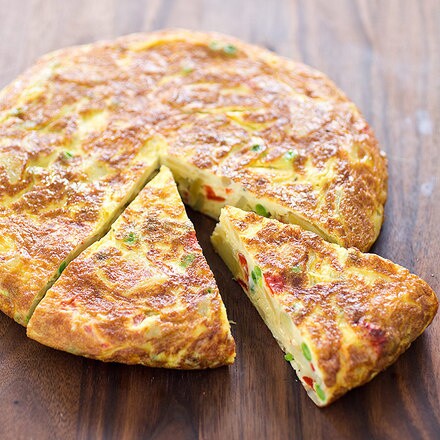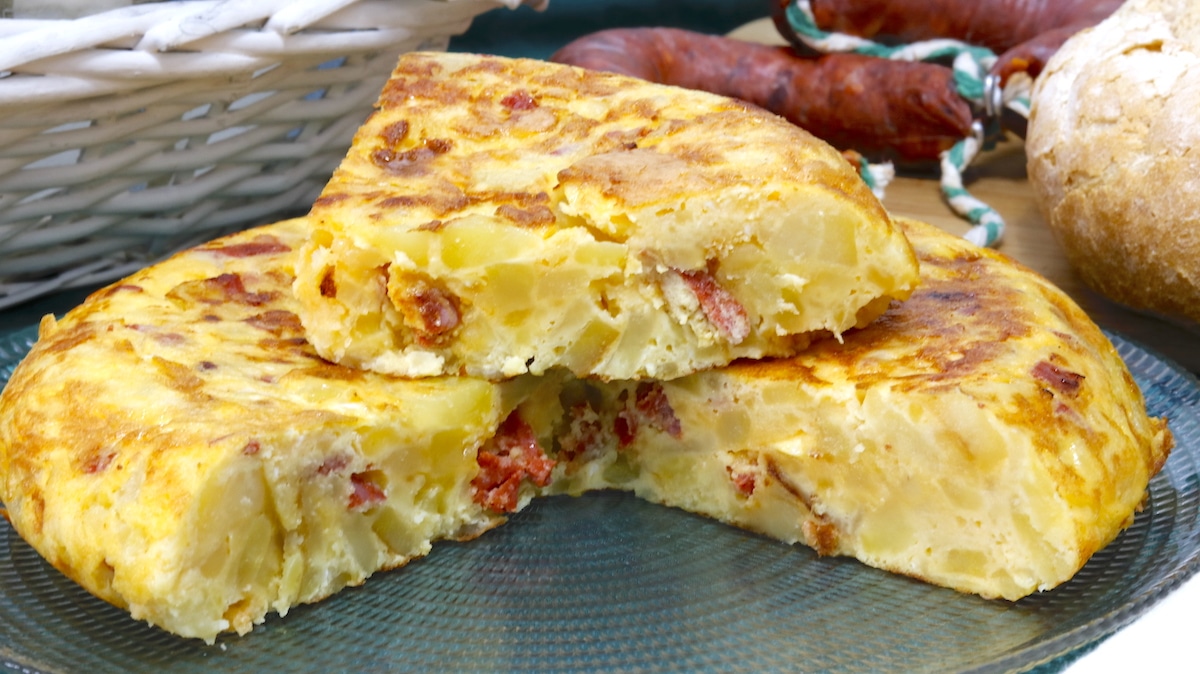

Maria Gonzalez
Maria Gonzalez is a culinary enthusiast and a passionate writer. Born and raised in Malaga, Andalusia, she has spent years exploring the rich culinary traditions of Spain. Her love for food and storytelling has led her to write about the dishes that have shaped her country’s culture and history. Today, she brings you a deep dive into one of Spain’s most beloved dishes, the Spanish Omelette.
Hello, dear readers! Today, we’re embarking on a delicious journey, one that takes us deep into the heart of Spanish cuisine. We’re exploring a dish that’s as comforting as a warm hug and as Spanish as flamenco – the Spanish Omelette. This humble yet delightful dish, with its golden potatoes and fluffy eggs, is a staple in every Spanish household and tapas bar. As a Malaga native, my heart fills with joy every time I flip a Spanish Omelette in my kitchen, the aroma taking me back to my childhood days. So, come along, dear friends, as we delve into the history, ingredients, and the art of cooking this beloved dish. Let’s discover why the Spanish Omelette is not just a dish, but a delicious slice of Spanish life.
History of the Spanish Omelette
Ah, the Spanish Omelette! A dish that has stood the test of time, a culinary delight that has warmed the hearts and bellies of Spaniards for centuries. But have you ever wondered where it all began? The origins of the Spanish Omelette, or Tortilla Española, are as rich and varied as the dish itself.
Picture this: a humble peasant living in the forests of Navarre, a region known for its lush landscapes and hearty cuisine. One cold winter night, a weary traveler knocks on his door, his stomach rumbling with hunger. With only eggs and potatoes in his pantry, the peasant whips up a simple yet satisfying dish. And thus, the Spanish Omelette was born. Or so the story goes.
Another tale takes us to the charming town of Villanueva de la Serena, in the province of Badajoz in southwestern Spain. Here, it is said, the Spanish Omelette was first created. While the true origins of the Spanish Omelette may remain a mystery, one thing is clear: this delightful dish quickly found its way into the hearts and homes of Spaniards far and wide.
The beauty of the Spanish Omelette lies in its simplicity and versatility. It’s a dish for all seasons and all times of the day. Whether served hot off the stove or cool from the fridge, as a hearty main or a tasty tapa, the Spanish Omelette never fails to satisfy.
Over the years, the Spanish Omelette has evolved, with each region of Spain adding its unique touch to the classic recipe. Yet, at its heart, the Spanish Omelette remains true to its roots – a comforting blend of eggs and potatoes, cooked to golden perfection.
Today, the Spanish Omelette is more than just a dish. It’s a symbol of Spanish culture, a culinary icon that’s as Spanish as flamenco and bullfighting. Its humble beginnings and enduring popularity are a testament to the timeless appeal of good, honest food.
So, the next time you tuck into a slice of Spanish Omelette, remember, you’re not just enjoying a meal. You’re savoring a piece of Spanish history.
The Basic Ingredients
Now, let’s talk about the stars of the show, the ingredients that make the Spanish Omelette the culinary delight that it is. The beauty of the Spanish Omelette lies in its simplicity, and this is reflected in its ingredients – potatoes, eggs, and sometimes, onions. Yes, that’s it! Just three humble ingredients come together to create a dish that’s loved by millions.
Potatoes: The Heart of the Dish
First up, we have potatoes, the heart and soul of the Spanish Omelette. The potatoes are a key ingredient that gives the omelette its characteristic texture and flavor. The way they are prepared, however, is a subject of much debate among Spanish Omelette enthusiasts.
Traditionally, the potatoes are thinly sliced, almost like potato chips, and then gently fried until they’re soft and tender. This method allows the potatoes to meld with the eggs during cooking, creating a creamy, almost custard-like texture in the finished omelette.
:max_bytes(150000):strip_icc()/__opt__aboutcom__coeus__resources__content_migration__simply_recipes__uploads__2016__12__06112708__2016-12-08-Potato-Stacks-9-4c4f3c1148d34647aa383c464ba2b913.jpg)
:max_bytes(150000):strip_icc()/__opt__aboutcom__coeus__resources__content_migration__simply_recipes__uploads__2016__12__06112708__2016-12-08-Potato-Stacks-9-4c4f3c1148d34647aa383c464ba2b913.jpg)
However, there’s another school of thought that advocates for the potatoes to be cut into cubes, or “en cubos” as it’s said in Spanish. The proponents of this method argue that cubed potatoes provide a more substantial texture to the omelette, making it heartier and more satisfying. The cubes of potatoes are fried until they’re golden and crispy on the outside, yet soft and fluffy on the inside. This contrast of textures adds another dimension to the omelette, making it even more delightful to eat.


The type of potato used can also vary, but it’s generally agreed that a waxy variety works best. Waxy potatoes hold their shape during cooking and don’t break down as easily as starchy potatoes, making them the ideal choice for a Spanish Omelette.
Also read our blog about: Spicy Potatoes, Also Known as Patatas Bravas: Top Spanish Cuisine
Eggs: The Binding Force
Next, we have eggs, the binding force of the Spanish Omelette. The eggs are beaten and mixed with the cooked potatoes, creating a mixture that’s then poured into a hot pan. The eggs cook slowly, enveloping the potatoes in a soft, fluffy blanket. The result? A golden, eggy delight that’s firm on the outside and soft on the inside.
Onions: A Controversial Addition
Last but not least, we have onions. Now, onions are a bit of a controversial ingredient in the world of Spanish Omelettes. Some swear by them, saying they add a sweet, caramelized flavor that elevates the dish to new heights. They argue that the onions, when cooked slowly and gently, develop a sweetness that balances the earthy flavor of the potatoes and the richness of the eggs. This faction believes that the onion is the secret ingredient that transforms a simple omelette into a culinary masterpiece.
On the other hand, there are those who insist that a true Spanish Omelette should only contain potatoes and eggs. They argue that the beauty of the dish lies in its simplicity and that adding onions muddies the flavors. This group often includes purists who adhere strictly to traditional recipes and believe that the original version is the best. They argue that the combination of potatoes and eggs, when cooked correctly, creates a dish that is so delicious in its simplicity that adding anything else is unnecessary.
This debate has been going on for as long as the Spanish Omelette has been around, and it doesn’t look like it’s going to be resolved anytime soon. In fact, it’s not uncommon for Spanish families to have heated debates about whether or not to include onions in their omelettes. It’s a topic that can divide households and turn friends into foes.
But here’s the beauty of cooking: you get to decide. The choice, dear readers, is entirely up to you. If you’re a fan of onions and love the sweet, caramelized flavor they bring to the dish, go ahead and add them. If you’re a purist who believes in the sanctity of the traditional recipe, feel free to leave them out. The most important thing is that you enjoy the process of cooking and the delicious result. After all, the best recipe is the one that tastes best to you. So go ahead, experiment, and make the Spanish Omelette your own.
So there you have it, the basic ingredients of the Spanish Omelette. Simple, isn’t it? But as we’ll see, it’s the way these ingredients are cooked that transforms them into a dish that’s truly special.
The Art of Cooking a Spanish Omelette
Now that we’ve met our ingredients, it’s time to roll up our sleeves and get cooking. The art of cooking a Spanish Omelette lies in the careful preparation of its ingredients and the patience with which it’s cooked. So, let’s dive in, shall we?
Preparing the Ingredients
Our journey begins with the preparation of our ingredients. The potatoes are peeled and either thinly sliced or cubed, depending on your preference, ready to be bathed in hot olive oil. The choice between sliced or cubed potatoes can influence the texture of your omelette, with slices providing a smoother texture and cubes offering a bit more bite. The onions, if you choose to use them, are finely chopped, their sweet aroma filling the kitchen. The eggs are cracked open, their yolks a vibrant yellow, waiting to be whisked into a frothy mixture. Each ingredient is prepared with care, setting the stage for the culinary magic that is about to happen.
Cooking the Potatoes and Onions
Next, we move on to the cooking. The potatoes and onions are gently fried in a generous amount of olive oil. The key here is to stew them gently, allowing them to soften and absorb the flavors of the oil. This step is crucial, as it gives the Spanish Omelette its characteristic texture and flavor
Also read our blog about:Spanish Olive Oil: The Heart of the Mediterranean Diet and Its Health Benefits
Combining the Ingredients and Cooking the Omelette
Once the potatoes and onions are cooked, they’re drained and added to the beaten eggs. The mixture is then poured into a hot pan and cooked over low heat. The trick here is to cook the omelette slowly, allowing the eggs to set and the flavors to meld together.
After a few minutes, the moment of truth arrives – the flip. With a swift and confident motion, the omelette is flipped over and cooked on the other side. This step can be a bit tricky, but with a bit of practice, you’ll be flipping omelettes like a pro!
Once the omelette is cooked to your liking, it’s slid onto a plate and left to cool. The result? A golden, delicious Spanish Omelette, ready to be enjoyed.
So, there you have it, dear readers. The art of cooking a Spanish Omelette. It’s a process that requires patience and love, but the end result is well worth it. Happy cooking!
Vegan Spanish Omelette
The Spanish Omelette is a versatile dish that can be adapted to suit various dietary needs, including a vegan diet. While the traditional recipe calls for eggs, a vegan Spanish Omelette replaces the eggs with a mixture of chickpea flour and water, creating a similar texture and taste. Let’s dive into how to make a Vegan Spanish Omelette.
Recipe for Vegan Spanish Omelette
Ingredients:
- 4 medium potatoes
- 1/2 onion
- 16 tablespoons of gram or chickpea flour
- 16 tablespoons of water
- Extra virgin olive oil
- Salt to taste
Instructions:
- Peel and slice or cube the potatoes. If you’re using onions, finely chop them.
- Heat a generous amount of olive oil in a non-stick pan over medium heat. Add the potatoes (and onions if using) and cook until they’re soft and tender. This should take about 20-30 minutes. Stir occasionally to prevent them from sticking to the pan.
- While the potatoes are cooking, mix the chickpea flour and water in a bowl. Whisk until it’s smooth and has the consistency of beaten eggs.
- Once the potatoes are cooked, drain the excess oil and add them to the chickpea mixture. Stir well to ensure that the potatoes are evenly coated.
- Heat a little more oil in the pan and pour in the potato and chickpea mixture. Cook over low heat for about 10 minutes, or until the bottom is golden brown.
- Carefully flip the omelette and cook for another 10 minutes on the other side.
- Once it’s cooked, slide the omelette onto a plate and let it cool for a few minutes before serving.
Variations of the Spanish Omelette
The beauty of the Spanish Omelette lies not just in its delicious taste, but also in its versatility. While the classic version is a delightful blend of potatoes and eggs, there are countless variations that add a unique twist to this beloved dish. Let’s explore some of these variations, each one a delicious testament to the creativity of Spanish cuisine.
Spanish Omelette with Zucchini
First up, we have the Spanish Omelette with zucchini. This variation adds a touch of green to the classic recipe. The zucchini is thinly sliced and cooked along with the potatoes, adding a subtle sweetness and a delightful crunch to the omelette.


This Spanish Omelette with Zucchini recipe is a delicious and nutritious option that’s perfect for a light lunch or dinner. Here’s how to make it:
Ingredients:
- 3-4 medium zucchinis
- 1 large white or sweet onion
- 6 large eggs
- 1 teaspoon salt, plus more for seasoning
- Olive oil for cooking
Instructions:
- Start by slicing the zucchinis and onion into thin slices.
- Heat some olive oil in a large frying pan and add the zucchini and onion. Cook until they are soft and golden.
- In a large bowl, beat the eggs and add the cooked zucchini and onion. Season with salt.
- Heat a little more olive oil in the frying pan and add the egg mixture. Cook on a low heat until the bottom is golden and the top is starting to set.
- Flip the omelette and cook until the other side is golden.
- Serve warm or at room temperature.
Spanish Omelette with Roasted Peppers
Next, we have the Spanish Omelette with roasted peppers. The peppers are roasted until they’re soft and sweet, then added to the potato and egg mixture. The result is a colorful and flavorful omelette that’s a feast for the eyes and the palate.


The sweet and smoky flavor of the peppers adds a unique twist to the classic Spanish Omelette. Here’s how to make it:
Ingredients:
- 3 tablespoons extra-virgin olive oil
- 1 large yellow onion, chopped
- 2 ounces Spanish chorizo (cured sausage), sliced into thin rounds
- 1 pound Yukon gold potatoes, peeled and sliced inch thick
- 1 red bell pepper (ribs and seeds removed), thinly sliced
- 6 large eggs
- Salt and pepper to taste
Instructions:
- Heat the olive oil in a large frying pan over medium heat. Add the onion, chorizo, potatoes, and bell pepper. Cook, stirring occasionally, until the potatoes are tender, about 15 minutes.
- In a large bowl, beat the eggs and season with salt and pepper. Add the cooked potato mixture and stir to combine.
- Return the frying pan to medium heat and add the egg mixture, spreading it evenly in the pan. Cook until the bottom is golden and the top is starting to set.
- Flip the omelette and cook until the other side is golden.
- Serve warm or at room temperature.
Spanish Omelette with Chorizo
For those who love a bit of spice, the Spanish Omelette with chorizo is a must-try. The chorizo is cooked until it’s crispy and its spicy oils are released. These oils are then used to cook the potatoes, infusing them with a spicy, smoky flavor that’s simply irresistible.


The spicy and smoky flavor of the chorizo adds a delicious depth to the omelette. Here’s how to make it:
Ingredients:
- 4 small waxy potatoes, scrubbed and cut into chunks
- 6 large free-range eggs
- 2 x 60 g iberico chorizo sausages, cut into 1cm thick slices
- 2 spring onions, trimmed and finely sliced
- Olive oil for cooking
Instructions:
- Start by boiling the potatoes until they are just tender. Drain and set aside.
- In a large bowl, beat the eggs and add the cooked potatoes, chorizo slices, and spring onions. Season with salt and pepper.
- Heat some olive oil in a large frying pan and add the egg mixture. Cook on a low heat until the bottom is golden and the top is starting to set.
- Flip the omelette and cook until the other side is golden.
- Serve warm or at room temperature.
Tortilla de Gambas: A Southern Spanish Delight
Now, let’s take a detour to the sunny shores of southern Spain, where a unique variation of the Spanish Omelette awaits us – the Tortilla de Gambas, or Shrimp Omelette. This delightful dish, with its crispy texture and seafood flavor, is a testament to the rich culinary traditions of Andalusia.
Originating from the beautiful city of Cádiz, the Tortilla de Gambas is a classic representation of southern Spain’s flavors. It’s a dish that perfectly captures the essence of the region – the warmth of the sun, the freshness of the sea, and the joy of sharing good food with loved ones.
Also read our blog about: Tinto de Verano: All You Need to Know About “Summer Wine”
The Tortilla de Gambas is made with tiny, fresh shrimp that are mixed with a batter of flour and water. The mixture is then spooned into hot olive oil and fried until it’s golden and crispy. The result is a deliciously crunchy omelette that’s bursting with the flavor of fresh shrimp.
What sets the Tortilla de Gambas apart from other variations of the Spanish Omelette is its unique texture. While the classic Spanish Omelette is soft and fluffy, the Tortilla de Gambas is delightfully crispy, offering a delightful contrast of textures that’s sure to tantalize your taste buds.
So, if you’re a seafood lover or if you’re just looking to try something different, the Tortilla de Gambas is a must-try. It’s a dish that brings the flavors of the sea to your plate, a delicious slice of southern Spain that you can enjoy in the comfort of your own home.
The Spanish Omelette in Spanish Culture
The Spanish Omelette, or Tortilla Española, is more than just a dish in Spain. It’s a symbol of Spanish culture, a culinary icon that’s as Spanish as flamenco and bullfighting. From family gatherings to local festivals, the Spanish Omelette is a dish that brings people together, a dish that’s shared with love and enjoyed with gusto.
A National Dish
Celebrated as a national dish by Spaniards, the Spanish Omelette is an essential part of the Spanish culinary landscape. Its popularity transcends regional boundaries, making it a dish that’s loved and enjoyed across the entire country. From the bustling streets of Madrid to the serene villages of Andalusia, the Spanish Omelette is a dish that’s as diverse as the country itself.
A Staple in Spanish Homes
In Spanish homes, the Spanish Omelette is a staple, a dish that’s often cooked with love and served with pride. It’s a dish that’s enjoyed at any time of the day, be it for breakfast, lunch, or dinner. It’s also a popular choice for picnics and packed lunches, thanks to its versatility and ease of transport.
A Star of Spanish Tapas
The Spanish Omelette is also a star of Spanish tapas. Served in small slices or bite-sized pieces, it’s a popular choice in tapas bars across Spain. Paired with a glass of Spanish wine or a cold beer, the Spanish Omelette is a dish that embodies the spirit of Spanish tapas – simple, delicious, and perfect for sharing.
A Symbol of Spanish Heritage
Finally, the Spanish Omelette is a symbol of Spanish heritage, a dish that carries with it centuries of history and tradition. It’s a dish that tells a story, a story of humble beginnings and enduring popularity. It’s a dish that, much like Spain itself, has a rich past and a vibrant present.
Top 5 Places to Eat Spanish Omelette in Malaga
If you’re in Malaga and craving a delicious Spanish Omelette, you’re in luck. This city is home to numerous eateries that serve up some of the best Spanish Omelettes you’ll ever taste. Here are the top 5 places to enjoy a Spanish Omelette in Malaga:
Brunchit – Alhondiga and Carreteria
Brunchit, with its two locations in Alhondiga and Carreteria, is a favorite among locals and tourists alike. Known for their delicious breakfast and brunch offerings, their Spanish Omelette is a must-try. It’s cooked to perfection and served with a side of fresh salad.


Also read our blog about: Best Restaurants at Muelle Uno: Top Dining Spots in Malaga
Uvedoble
Next up, we have Uvedoble. This trendy tapas bar serves a variety of Spanish dishes, but their Spanish Omelette is a standout. It’s fluffy, flavorful, and served with a unique twist – a side of aioli for an extra burst of flavor.


La Recova
La Recova is a charming cafe known for its Spanish Omelette. It’s a cozy spot to enjoy a leisurely breakfast or lunch. Their Spanish Omelette, with its perfect balance of eggs and potatoes, is a crowd-pleaser.


La Proa de Teatinos
La Proa de Teatinos is another great spot to enjoy a Spanish Omelette. This seafood restaurant may be known for its fish dishes, but their Spanish Omelette is equally impressive. It’s cooked just right – firm on the outside and soft on the inside.


El Tapeo de Cervantes
Finally, we have El Tapeo de Cervantes. This popular tapas bar serves a variety of Spanish dishes, but their Spanish Omelette is a favorite among patrons. It’s served in small, bite-sized pieces, perfect for sharing with friends over a glass of Spanish wine.
So, there you have it, the top 5 places to enjoy a Spanish Omelette in Malaga. Each of these eateries offers a unique take on this classic dish, making them worth a visit the next time you’re in the city.


Top Places to Eat Vegan Spanish Omelette in Malaga
MIMO Vegan: Located on Avenida Manuel Agustin Heredia, MIMO Vegan is a must-visit for any vegan food lover. Their menu features a variety of plant-based dishes, including a vegan version of the Spanish Omelette.
La Vegana Taperia: As the first authentic vegan tapas bar in Malaga, La Vegana Taperia offers a variety of vegan dishes, including a tasty Vegan Spanish Omelette.
Also read our blog about: Top 5 Vegan Restaurants in Malaga: Complete Guide
And there you have it, dear readers – our journey through the world of the Spanish Omelette comes to an end. But as we know, every end is just a new beginning. The beauty of the Spanish Omelette lies not just in its taste, but in its ability to bring people together, to create memories, and to add a dash of Spanish charm to our lives. So, the next time you’re in the kitchen, why not whip up a Spanish Omelette? As you slice through the golden layers of potatoes and eggs, remember, you’re not just making a dish, you’re bringing a piece of Spain into your home. Until next time, happy cooking, and as we say in Spain, ¡Buen provecho!




